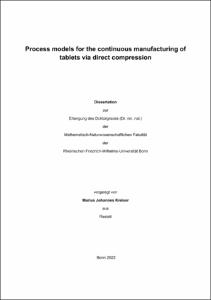Process models for the continuous manufacturing of tablets via direct compression

Process models for the continuous manufacturing of tablets via direct compression

| dc.contributor.advisor | Wagner, Karl G. | |
| dc.contributor.author | Kreiser, Marius Johannes | |
| dc.date.accessioned | 2022-12-08T16:19:09Z | |
| dc.date.available | 2022-12-08T16:19:09Z | |
| dc.date.issued | 08.12.2022 | |
| dc.identifier.uri | https://hdl.handle.net/20.500.11811/10515 | |
| dc.description.abstract | The modularity of the continuous manufacturing line PCMM is accompanied by a complexity of parameter connections and process dependencies. To develop a holistic understanding of the continuous process, this work examined the interaction of material attributes, setting parameters and the influence on the subsequent parameters and tablet properties.
During the development of the appropriate feeder set-up, the correct combination of screw pitch (ScP), gearbox type (GB), top up volume (TU) and refill level (RL) needs to be chosen to ensure a consistent feed rate. Therefore, three DoEs were carried out using microcrystalline cellulose, dicalcium phosphate and sodium starch glycolate to identify the parameters which reduce variability in feed rate. It could be shown that mainly ScP and RL significantly impacted the feed performance for all raw materials (chapter 5). Changes in ScP and density variation of the raw materials result in a change of the feed factor (FF) curve between two refills, which may affect the refill strategy. To comprehend to what extent the FF curve is influenced by lot-to-lot variability and feeder settings, a method was developed to predict the FF curve during a complete hopper dispensing based on conditioned bulk density (CBD), compressibility (Comp), throughput (THR) and ScP (chapter 6). Regarding the continuous mixer, different combinations of the three CMT parameters (THR, hold up mass (HUM) and impeller speed (IMP)) result in different mean residence times (MRTs) and total blade passes (TBP), influence the lubrication of the blend and impact the downstream process parameters. Using a DoE with two different formulations, significant impacts on the mixing parameters, material attributes of the blend, tableting parameters and tablet properties could be found (chapters 7 and 8). To additionally investigate the impact of the drug load (DL) on the blend uniformity in combination with THR and IMP, another DoE was performed. The findings regarding the impact of the CMT parameters on the subsequent process in chapters 7 and 8 could be confirmed. Regarding the DL, it seemed that the attributes of the API surrogate were transferred to the blend according to the proportion in the formulation. Furthermore, it could be shown that lower API concentrations resulted in higher variability. Nevertheless, a highly efficient mixing quality could be proved with mass balance model (MBM) variability smaller than 1% (chapter 9). The data of chapters 7 and 9 were combined and a new model was built. Since the basic formulation was the same and only composition changes were made, a theoretical “input density“ could be calculated based on the density of the individual ingredients and the proportion in the formulation. I.e., the impact on the continuous process could be evaluated based on the raw material attributes and the CMT parameters. Regarding the tensile strength (TS), the compression pressure was used as an additional factor. For all evaluated parameters (Exit Valve Opening Width, Fill Depth, Conditioned Bulk Density and TS), significant models could be obtained (chapter 10). | en |
| dc.language.iso | eng | |
| dc.rights | In Copyright | |
| dc.rights.uri | http://rightsstatements.org/vocab/InC/1.0/ | |
| dc.subject | continuous manufacturing of tablets | |
| dc.subject | continuous feeding | |
| dc.subject | continuous mixing technology | |
| dc.subject | vertical blender | |
| dc.subject | direct compression | |
| dc.subject | lubrication | |
| dc.subject | material characterization | |
| dc.subject | model development | |
| dc.subject | PCMM | |
| dc.subject.ddc | 500 Naturwissenschaften | |
| dc.title | Process models for the continuous manufacturing of tablets via direct compression | |
| dc.type | Dissertation oder Habilitation | |
| dc.publisher.name | Universitäts- und Landesbibliothek Bonn | |
| dc.publisher.location | Bonn | |
| dc.rights.accessRights | openAccess | |
| dc.identifier.urn | https://nbn-resolving.org/urn:nbn:de:hbz:5-68878 | |
| dc.relation.doi | https://doi.org/10.3390/pharmaceutics14020278 | |
| ulbbn.pubtype | Erstveröffentlichung | |
| ulbbnediss.affiliation.name | Rheinische Friedrich-Wilhelms-Universität Bonn | |
| ulbbnediss.affiliation.location | Bonn | |
| ulbbnediss.thesis.level | Dissertation | |
| ulbbnediss.dissID | 6887 | |
| ulbbnediss.date.accepted | 05.12.2022 | |
| ulbbnediss.institute | Mathematisch-Naturwissenschaftliche Fakultät : Fachgruppe Pharmazie / Pharmazeutisches Institut | |
| ulbbnediss.fakultaet | Mathematisch-Naturwissenschaftliche Fakultät | |
| dc.contributor.coReferee | Lamprecht, Alf | |
| ulbbnediss.contributor.orcid | https://orcid.org/0000-0003-2627-8409 | |
| ulbbnediss.contributor.gnd | 1281238384 |
Files in this item
This item appears in the following Collection(s)
-
E-Dissertationen (4311)




